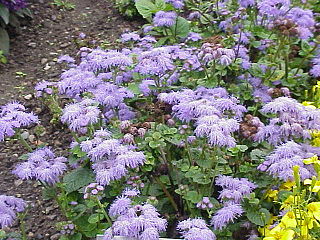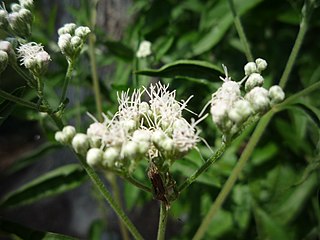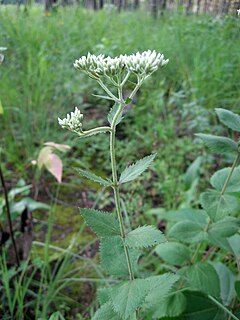
Eupatorium is a genus of flowering plants in the aster family, Asteraceae, containing from 36 to 60 species depending on the classification system. Most are herbaceous perennials growing to 0.5–3 m (1.6–9.8 ft) tall. A few are shrubs. The genus is native to temperate regions of the Northern Hemisphere. Most are commonly called bonesets, thoroughworts or snakeroots in North America. The genus is named for Mithridates Eupator, king of Pontus.

Eupatorieae is a tribe of over 2000 species of plants in the aster family. Most of the species are native to tropical, subtropical, and warm temperate areas of the Americas, but some are found elsewhere. Well-known members are Stevia rebaudiana, a number of medicinal plants (Eupatorium), and a variety of late summer to autumn blooming garden flowers, including Ageratum (flossflower), Conoclinium (mistflower), and Liatris.

Eupatorium altissimum, the tall thoroughwort, is a perennial plant whose native range includes much of the eastern and central United States and Canada (Ontario south to Nebraska, eastern Texas, the Florida Panhandle, and Massachusetts. It almost always grows on limestone soils, as does Brickellia eupatorioides, with which it is often confused. It can hybridize with Eupatorium serotinum.

Eupatorium serotinum, also known as late boneset or late thoroughwort, is a fall-blooming herbaceous plant native to North America.

Eupatorium hyssopifolium, also known as hyssopleaf thoroughwort, is a fall-blooming herbaceous plant native to North America. Like other members of the genus Eupatorium it has inflorescences containing a large number of very small flower heads, each with 5 white disc florets but no ray florets. At 0.5 to one meter tall, it is towards the shorter end of the range of heights found in Eupatorium species.

Eupatorium album, or white thoroughwort, is a herbaceous perennial plant in the sunflower family native from the eastern and southern United States, from eastern Texas to Connecticut, inland as far as Indiana.
Eupatorium compositifolium commonly called Yankeeweed is a North American herbaceous perennial plant in sunflower family native to the southern United States. Like other members of the genus Eupatorium it has inflorescences containing a large number of small, white flower heads, each with 5 disc florets but no ray florets. The plant is 0.5 to 2 metres tall.
Eupatorium leptophyllum, commonly called false fennel, is a herbaceous perennial plant in Asteraceae native to the southeastern United States from Mississippi to the Carolinas. Like other members of the genus Eupatorium, it is about one to two meters tall and has inflorescences containing a large number of tiny white flower heads, each with 5 disc florets but no ray florets. E. leptophyllum grows in wet areas and can grow in shallow water, often at the edges of ponds.

Eupatorium mikanioides, commonly called semaphore thoroughwort, is a herbaceous perennial plant in Asteraceae found only in the US state of Florida.

Eupatorium mohrii, commonly called Mohr's thoroughwort, is a herbaceous perennial plant in Asteraceae native to the southeastern and south-central states of the United States, in the coastal plain from Virginia to Texas. It has also been found in the Dominican Republic.

Eupatorium resinosum, or pine barren thoroughwort, is a rare North American plant species in the sunflower family.

Eupatorium rotundifolium, commonly called roundleaf thoroughwort, is a North American species of plant in sunflower family. It native to the eastern and central United States, in all the coastal states from Maine to Texas, and inland as far as Missouri and the Ohio Valley. It is found in low, moist habitats such as wet savannas and bogs.
Eupatorium semiserratum, commonly called smallflower thoroughwort, is a North American plant species in the sunflower family. It is native to the southeastern and south-central United States, found in all the coastal states from Maryland to Texas and inland as far as Missouri and Kentucky.

Eupatorium sessilifolium, commonly called upland boneset or sessile-leaved boneset, is a North American plant species in the sunflower family. It is native to the eastern and central United States, found from Maine south to North Carolina and Alabama, and west as far as Arkansas, Kansas, and Minnesota.
Eupatorium linearifolium is a fall-blooming herbaceous plant native to North America.

Ageratina luciae-brauniae is a species of flowering plant in the aster family known by the common names Lucy Braun's snakeroot and rockhouse white snakeroot. It is native to the eastern United States, where it is limited to the Cumberland Plateau of Kentucky and Tennessee. It may also occur in South Carolina but these reports are unconfirmed.
Chromolaena bigelovii called Bigelow's false thoroughwort, or Bigelow's thoroughwort, is a North American species of flowering shrub in the sunflower family. It is native to northeastern Mexico and the US State of Texas.
Eupatorium novae-angliae, commonly called New England boneset, New England justiceweed or New England thoroughwort, is a rare and endangered North American species in the sunflower family. It is found only in 4 counties in southern New England. The species is listed as endangered species in both states.
Eupatorium godfreyanum, commonly called Godfrey’s thoroughwort, is a North American species of plants in the sunflower family. It is found in the east-central United States, primarily from Pennsylvania to North Carolina, with a few isolated populations west of the Appalachians in Ohio, Kentucky, and Tennessee.
Eupatorium anomalum, commonly called Florida thoroughwort, is a North American species in the sunflower family. It grows in the southeastern United States from Alabama to Virginia. Molecular investigations suggest that it originated as a hybrid between E. serotinum and E. mohrii but it is well-established on its own as a distinct species.











